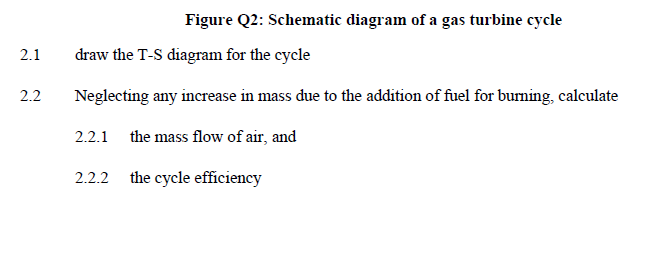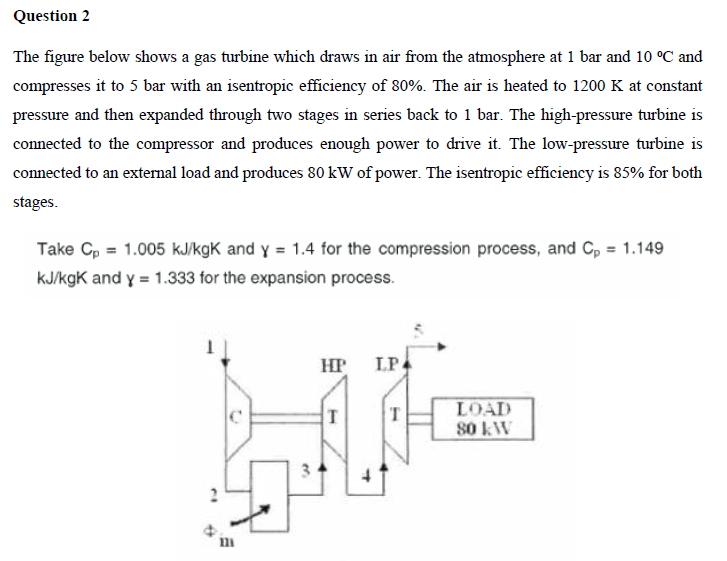2.1 2.2 Figure Q2: Schematic diagram of a gas turbine cycle draw the T-S diagram for the cycle Neglecting any increase in mass due to the addition of fuel for burning, calculate 2.2.1 the mass flow of air, and 2.2.2 the cycle efficiency
2.1 2.2 Figure Q2: Schematic diagram of a gas turbine cycle draw the T-S diagram for the cycle Neglecting any increase in mass due to the addition of fuel for burning, calculate 2.2.1 the mass flow of air, and 2.2.2 the cycle efficiency
Elements Of Electromagnetics
7th Edition
ISBN:9780190698614
Author:Sadiku, Matthew N. O.
Publisher:Sadiku, Matthew N. O.
ChapterMA: Math Assessment
Section: Chapter Questions
Problem 1.1MA
Related questions
Question
QUESTION 2
Kindly answer correctly. Please show all the necessary steps. Thank you so much in advance.

Transcribed Image Text:2.1
2.2
Figure Q2: Schematic diagram of a gas turbine cycle
draw the T-S diagram for the cycle
Neglecting any increase in mass due to the addition of fuel for burning, calculate
2.2.1 the mass flow of air, and
2.2.2 the cycle efficiency

Transcribed Image Text:Question 2
The figure below shows a gas turbine which draws in air from the atmosphere at 1 bar and 10 °C and
compresses it to 5 bar with an isentropic efficiency of 80%. The air is heated to 1200 K at constant
pressure and then expanded through two stages in series back to 1 bar. The high-pressure turbine is
connected to the compressor and produces enough power to drive it. The low-pressure turbine is
connected to an external load and produces 80 kW of power. The isentropic efficiency is 85% for both
stages.
Take Cp = 1.005 kJ/kgk and y = 1.4 for the compression process, and Cp = 1.149
kJ/kgk and y = 1.333 for the expansion process.
2
111
3
HP
Т
LP
LOAD
80 kW
Expert Solution
This question has been solved!
Explore an expertly crafted, step-by-step solution for a thorough understanding of key concepts.
Step by step
Solved in 4 steps with 1 images

Knowledge Booster
Learn more about
Need a deep-dive on the concept behind this application? Look no further. Learn more about this topic, mechanical-engineering and related others by exploring similar questions and additional content below.Recommended textbooks for you

Elements Of Electromagnetics
Mechanical Engineering
ISBN:
9780190698614
Author:
Sadiku, Matthew N. O.
Publisher:
Oxford University Press

Mechanics of Materials (10th Edition)
Mechanical Engineering
ISBN:
9780134319650
Author:
Russell C. Hibbeler
Publisher:
PEARSON

Thermodynamics: An Engineering Approach
Mechanical Engineering
ISBN:
9781259822674
Author:
Yunus A. Cengel Dr., Michael A. Boles
Publisher:
McGraw-Hill Education

Elements Of Electromagnetics
Mechanical Engineering
ISBN:
9780190698614
Author:
Sadiku, Matthew N. O.
Publisher:
Oxford University Press

Mechanics of Materials (10th Edition)
Mechanical Engineering
ISBN:
9780134319650
Author:
Russell C. Hibbeler
Publisher:
PEARSON

Thermodynamics: An Engineering Approach
Mechanical Engineering
ISBN:
9781259822674
Author:
Yunus A. Cengel Dr., Michael A. Boles
Publisher:
McGraw-Hill Education

Control Systems Engineering
Mechanical Engineering
ISBN:
9781118170519
Author:
Norman S. Nise
Publisher:
WILEY

Mechanics of Materials (MindTap Course List)
Mechanical Engineering
ISBN:
9781337093347
Author:
Barry J. Goodno, James M. Gere
Publisher:
Cengage Learning

Engineering Mechanics: Statics
Mechanical Engineering
ISBN:
9781118807330
Author:
James L. Meriam, L. G. Kraige, J. N. Bolton
Publisher:
WILEY